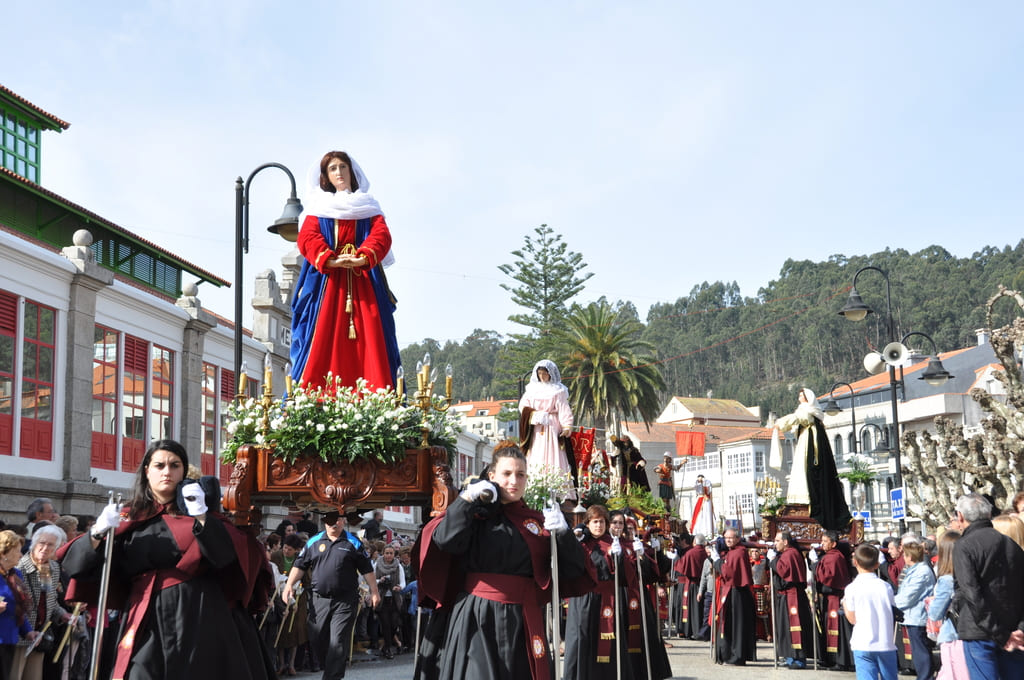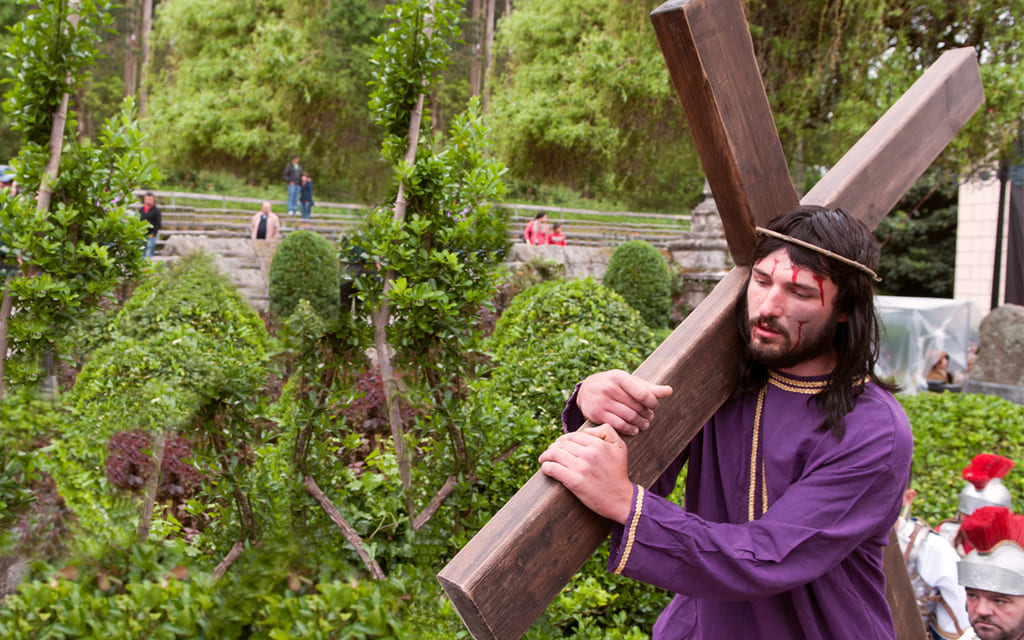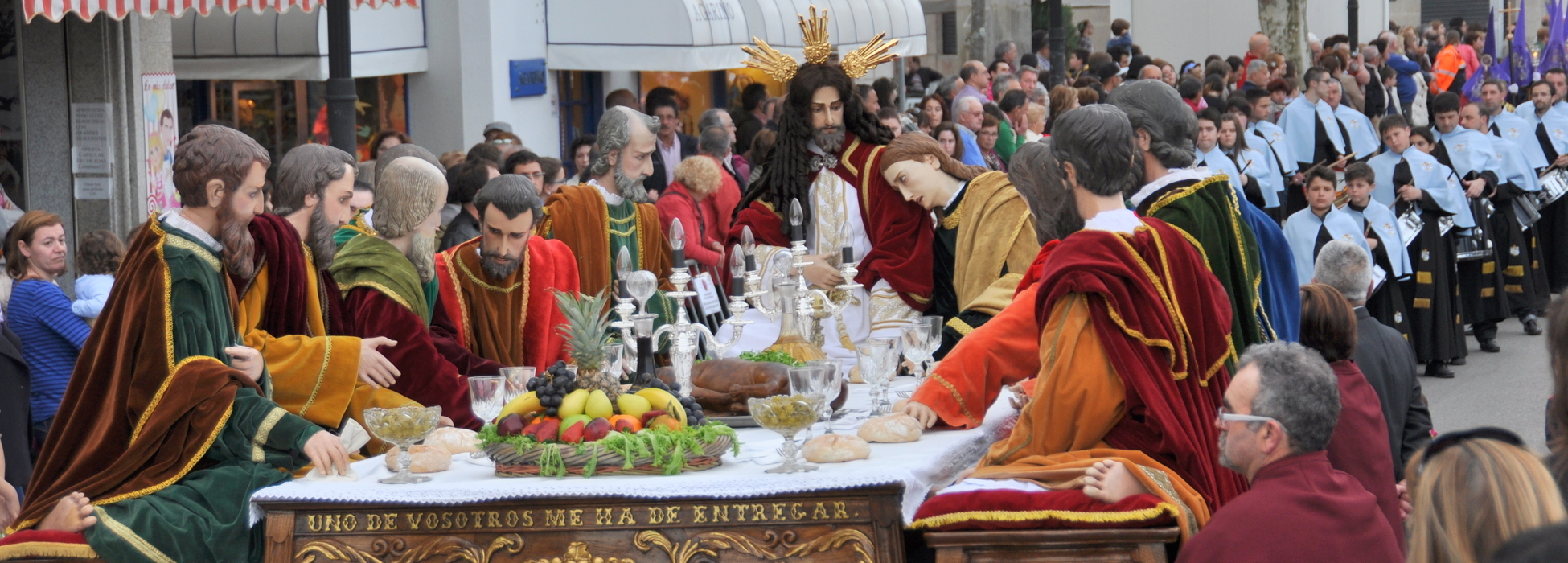Holy Week in As Rías Baixas
If one must pick two hubs of activity during the Holy Week celebrations in the province of Pontevedra, they would be, without a doubt, the municipalities of Cangas and Meis. Their traditions, which are recognised as Festivals of Tourist Interest in Galicia, are the epitome of solemnity, realism and high spirituality. You will relive the Passion of Christ!
CANGAS
High participation is one of the distinguishing features of the Holy Week in Cangas, nowadays consolidated and deeply rooted in the region of O Morrazo. The Confraría da Virxe das Dores e da Soidade (Church Brotherhood of the Virgin of Sorrows and Solitude), the Confraría do Santísimo Cristo do Consolo (Church Brotherhood of the Holy Christ of Consolation) and the Confraría do Santísimo Cristo da Misericordia (Church Brotherhood of the Holy Christ of Mercy) date back to the 18th century. Their rituals have been enhanced over the years and they have led to one of the most eye-catching and artistic reenactments, as well as one of the most spiritual. Today, this tradition is considered one of the most complete and most spectacular in the province of Pontevedra.
The statues, which stand out because they are articulated but also due to their size and decorations, are preceded by the procession of the hooded penitents. These figures are almost unique in Galicia and they bear the mark of Master Cerviño, the Galician sculptor that made the cruceiro (stone cross) of the parish of O Hío.
The articulated and beautifully decorated statues, by the Master Cerviño, are transported through the old town of Cangas during the procession of the Santo Encontro (Holy Meeting)
Good Friday is the main day because that is when the morning procession, known as A Negación de San Pedro (The Denial of Saint Peter) takes place. Right after, The Santo Encontro (Holy Meeting) reenacts the Passion of Christ. At this point, the articulated figures of Saint John, Saint Veronica along with the Tres Marías (The Three Marys) and the Holy Virgin of Sorrows are the ones that amaze the crowds in the old town. These images meet the Paso do Nazareno ( float of The Nazarene) at A Constitución Square, accompanied by Simon of Cyrene and Roman executioners. In the afternoon, the reenactment of the Descent of the Cross takes place, which is when the articulated image of the Christ is unnailed and placed inside a crystal coffin at the feet of the Virgin of Sorrows. Excitement and realism join a scene that has continuity with the procession of the Santo Enterro (Holy Entombment) and of the Silencio (Silence) at midnight. Candles are the only illumination, the drums set the pace and the members of the brotherhood make this moment unique.

MEIS
The parish of Paradela, in the town of Meis, is home to another of the best-known celebrations in the Galician Holy Week. Even though its origin is uncertain, we know that it dates back to the 18th century, when a statue of Jesus was acquired. In the past, the representations took place inside the church – by means of an articulated statue that performed the moment when Jesus was unnailed from the Cross –, but today these rituals have been taken to the streets, a tradition of great popularity since 1920. Realism is the main feature of this tradition where all the biblical passages about the Passion of Christ are reenacted live.
Nowadays, the Last Supper or the Resurrection on Easter Sunday are some of the moments that can be lived at this singular and peculiar event. Other relevant scenes of this Holy Week are the blessing of Palm Sunday, the Arrest of Jesus and the Sanhedrin Trial of Jesus on Maundy Thursday, the last hours of Jesus's life with the Stations of the Cross, the removal of Jesus's crucifixion nails and his descent from the cross or the procession of the Holy Entombment on Good Friday, as well as the blessing of water and fire.

PONTEVEDRA
Holy Week in Pontevedra has its origin in the 15th century. Nowadays, attending this liturgy means living unique moments . Some of the most important processions are the statue of Jesus entering Jerusalem, the Cristo das Caídas (Christ of the Falls), Jesus Nazarene and Holy Mary of Hope, the Holy Virgin of Solitude and Jesus, Os Pasos, the Holy Meeting with the penitential Stations of the Cross, the Holy Entombment of Christ or the meeting of Risen Jesus and his mother, the Virgin Mary.
VIGO
The Passion of Christ can also be relived on Palm Sunday in Vigo, with the procession of La Borriquita, led by a donkey. On Maundy Thursday, the procession of The Passion of Christ leaves the Church of O Sagrado Corazón, the procession of Our Father Jesus Nazarene takes the streets of the neighbourhood of Teis, and the procession of the Virgin of Sorrows takes place in the neighbourhood of Bouzas. On Good Friday, the processions of the meeting of Jesus and his mother, the Virgin of Solitude and the Holy Entombment of Christ take the streets.
BAIONA
On Maundy Thursday the procession popularly known as Os Pasos takes place with living figures and on Good Friday the procession of The Holy Entombment of Christ – or procession of men – is represented. The procession of The Holy Virgin of Sorrows – or the procession of women – closes the events of the municipality.
A GUARDA
A Guarda celebrates the mass in coena domini, the procession of Os Pasos and the Holy Eucharist. The Adoration of the Cross takes place on Good Friday with the procession of the meeting of Jesus and his mother, the sermon of the Seven Last Words from the Cross and The Holy Entombment of Christ. The procession of the Virgin of Solitude with the Stations of the Cross, the Easter Vigil and the Solemn Mass of Glory are the final events of the Holy Week tradition on Holy Saturday.








